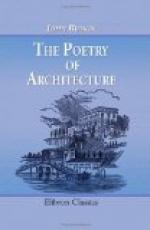avoided in all buildings, and especially in positive
and unmanageable tints. It is difficult to imagine
whence the custom of putting stone ornaments into
brick buildings could have arisen; unless it be an
imitation of the Italian custom of mixing marble with
stucco, which affords it no sanction, as the marble
is only distinguishable from the general material
by the sharpness of the carved edges. The Dutch
seem to have been the originators of the custom; and,
by the by, if we remember right, in one of the very
finest pieces of coloring now extant, a landscape
by Rubens (in the gallery at Munich, we think), the
artist seems to have sanctioned the barbarism, by
introducing a brick edifice, with white stone quoining.
But the truth is that he selected the subject, partly
under the influence of domestic feelings, the place
being, as it is thought, his own habitation, and partly
as a piece of practice, presenting such excessive
difficulties of color, as he, the lord of color, who
alone could overcome them, would peculiarly delight
in overcoming; and the harmony with which he has combined
tints of the most daring force, and sharpest apparent
contrast, in the edgy building, and opposed them to
an uninteresting distance of excessive azure (simple
blue country, observe), is one of the chief wonders
of the painting: so that this masterpiece can
no more furnish an apology for the continuance of
a practice which, though it gives some liveliness of
character to the warehouses of Amsterdam, is fit only
for a place whose foundations are mud, and whose inhabitants
are partially animated cheeses,—than Caravaggio’s
custom of painting blackguards should introduce an
ambition among mankind in general of becoming fit
subjects for his pencil. We shall have occasion
again to allude to this subject, in speaking of Dutch
street effects.
194. Fourthly. It will generally be found
to agree best with the business-like air of the blue
country, if the house be excessively simple, and apparently
altogether the minister of utility; but, where it
is to be extensive, or tall, a few decorations about
the upper windows are desirable. These should
be quiet and severe in their lines, and cut boldly
in the brick itself. Some of the minor streets
in the King of Sardinia’s capital are altogether
of brick, very richly charged with carving, with excellent
effect, and furnish a very good model. Of course
no delicate ornament can be obtained, and no classical
lines can be allowed; for we should be horrified by
seeing that in brick which we have been accustomed
to see in marble. The architect must be left to
his own taste for laying on, sparingly and carefully,
a few dispositions of well proportioned line, which
are all that can ever be required.
195. These broad principles are all that need
be attended to in simple blue country: anything
will look well in it which is not affected; and the
architect, who keeps comfort and utility steadily in
view, and runs off into no expatiations of fancy,
need never be afraid here of falling into error.




